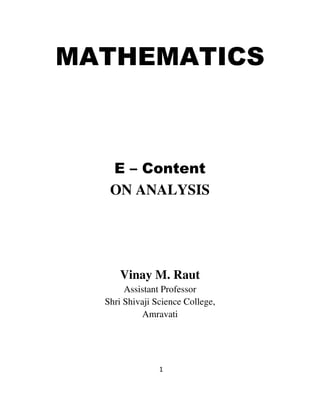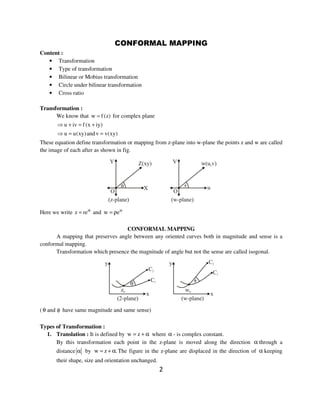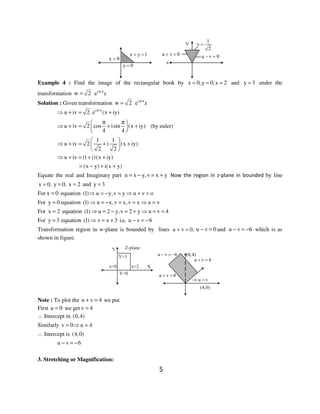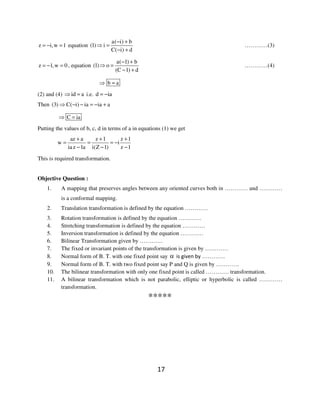1. The document discusses various types of transformations in complex analysis, including translation, rotation, stretching, and inversion.
2. Under inversion (1/w=z), a straight line is mapped to a circle if it does not pass through the origin, and to another straight line if it does pass through the origin. A circle is always mapped to another circle.
3. A general bilinear or Möbius transformation can be expressed as a combination of translation, rotation, stretching, and inversion.



![4
2. Rotation :
Let the mapping w f(z)= be in the form i 0
w z.e θ
= where 0 realconstantθ =
By this transformation figure in the z-plane are rotated through an angle 0θ in w-plane.
Example 3 : With the help of transformation i /4
w ze π
= determine the region in w-plane corresponding to
the triangular region bounded by the lines x 0,y 0= = and x y 1+ = in z-plane
Solution : Given transformation i /4
w ze π
= (rotation type) put the value of w and z
u iv (x iy) cos isin
4 4
π π
+ = + +
1 1
(x iy) i
2 2
= + +
(By Euler formula i
e cos isinθ
= + θ )
1
(x iy)(1 i)
2
= + +
[ ]
1 1
(x xi iy y) (x y) i(x y)
2 2
= + + − = − + +
Equate real and Imaginary part on both sides
1
u (x y)
2
= − and
1
v (x y)
2
= + …………(1)
Now the region z-plane is bounded by the lines x 0,y 0, x y 1= = + =
For x 0= equation
1
(1) u ( y),
2
⇒ −
1
v (y) u v 0
2
= ⇒ + =
For y 0= equation
x x
(1) u ,v u v 0
22
⇒ = = ⇒ − =
For x y 1+ = equation
1
(1) v
2
⇒ =
Transform region in w-plane is bounded by the lines u v 0,+ = u v 0− = and
1
v
2
= Which in as shown
in figure.](https://image.slidesharecdn.com/conformalmapping-201210092701/85/Conformal-mapping-4-320.jpg)




![9
Theorem : A General linear transformation is a combination of the transformation of translation,
rotation and stretching.
Proof : Consider linear transformation
W z= α +β …………(1)
Where α and β are complex constant
Let i 0
a e 0θ
α = ≠ …………(2)
We define the following transformation
3f (z) azλ = = is magnification
i 0
2f ( ) e θ
ρ = λ = λ is rotating
1w f ( )= ρ = ρ +β is translation
Consider,
1 2 3 1 2 3(f f f )(z) f f [f (z)]=
1 2(f f )(az)=
1 2f [f (az)]=
i 0
1f (e az)θ
=
i 0
e az zθ
= +β =α +β [By equation (2)]
f(z)= [By equation (1)]
w=
Thus the L. T. is combination of translation rotation and magnification.
Theorem : The bilinear transformation is a combination of translation, rotation stretching and inversion.
Proof : The bilinear transformation is given by
z
w ,
z
α + β
=
γ + δ
oαδ −βγ ≠ …………(1)
Where , , andα β γ δ are complex constant
∴ equation (1) can be written as
(z / )
W
(z / )
α + β γ
=
γ + δ γ
Add /±δ γ
[(z / ) ( / / )]
[z / ]
α + δ γ + β α −δ γ
=
γ + δ γ
/ /
/ 1
(2 / )
β α −δ γ
=α γ +
+δ γ
W
z
µ
= λ +
+ η
…………(2)](https://image.slidesharecdn.com/conformalmapping-201210092701/85/Conformal-mapping-9-320.jpg)
![10
Where,
α
λ =
γ
( / / )α β α −δ γ
µ =
γ
/η =δ γ
We define
1 2 3 1 2 3f f f (z) f f [f (z)]=
1 2f f (z )= + η
1
1
f
z
=
+ η
z
µ
= + λ
+ η
W=
f(z)=
Thus the B.T. is combination of L.T., Inversion and translation. But L.T. is combination of
magnification, translation and rotation.
∴ B. T. in combination of translation, rotation magnification and inversion.
Fixed Point of Invariant Point :
The fixed or invariant point of the transformation w f(z)= are the points given by z f (z)=
Theorem : Every bilinear transformation with a single non-infinite fixed point can be put in the form.
1 1
k
W P Z P
= +
− −
(Proof in Book)
Theorem 2 : Every B. T. with two non-infinite fixed point P and Q is of the form
w P z P
k
w Q z Q
− −
=
− −
(Proof in Book)
Where ‘k’ is constant
Note : The B. T. having two fixed point P and Q is given by
w P z P
k
w Q z Q
− −
=
− −
where ‘k’ is constant then B. T. is
1. Parabolic : Fixed point one
2. Elliptic : Fixed point two, k 1=
3. Hyperbolic : Fixed point two, k 1≠ and
4. Loxodromic : Other than above
Example 7 : Find the fixed point and normal form of the B. T.
3z 4
w
z 1
−
=
−](https://image.slidesharecdn.com/conformalmapping-201210092701/85/Conformal-mapping-10-320.jpg)






